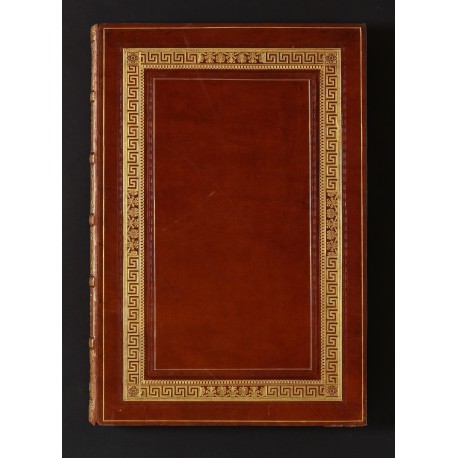 View larger
View larger
Antiquities of Athens and other places in Greece, Sicily etc. Supplementary to the Antiquities of Athens by James Stuart…and Nicholas Revett, Delineated and illustrated by C.R. Cockerell… W. Kinnard, T.L. Donaldson, W. Jenkins, W. Railton, Architects
- Subjects
- Architecture, Greek
- Greece - Description and travel
- Italy - Description and travel
- Authors/Creators
- Revett, Nicholas, 1720-1804
- Stuart, James, 1713-1788
- Printers/Publishers
- Priestley, Widow of George (Mary), active 1819?-1833?
- Weale, John, active 1819?-1833?
- Other names
- Cockerell, Charles Robert, 1788-1863
- Donaldson, Thomas Leverton, 1795-1885
- Kinnard, William, c. 1788-1839
- Railton, William, 1800-1877
Stuart, James and Nicholas Revett
London 1713 – 1788 London; Brandeston Hall, Suffolk 1720 – 1804 London
Antiquities of Athens and other places in Greece, Sicily etc. Supplementary to the Antiquities of Athens by James Stuart…and Nicholas Revett, Delineated and illustrated by C.R. Cockerell… W. Kinnard, T.L. Donaldson, W. Jenkins, W. Railton, Architects.
London, Priestley and Weale, 1830
folio (525 × 355 mm), (62) ff. letterpress, signed (a)2 (half-title; title) b2 (dedication; Advertisement) c2 (List of Subscribers) d1 (Contents of this Volume) (A)1 (part-title, The Temple of Jupiter Olympus…) B–C2 D1,2A2 (2A1, part-title, Antiquities of Athens and Delos…)2B–G22H2 (– 2H2, cancelled, possibly = d1), 3B2 (3B1, part-title, The Temple of Apollo Epicurius…) 3C–P2, 4A2 (4A1, part-title, Further Elucidations of Stuart and Revett’s Antiquities of Athens…) 4B1, 5A2 (5A1, part-title, The Newly discovered Temple at Cadachio…) 5B1, and paginated (1–9) 11 (12–14), (2) 1–10, (1)–30, (1)–56, (1)–5 (1), (1)–6, with engraved vignettes on title, other engraved illustrations with the text (including a vignette on india paper (3K1, ‘Greek Theatre’), and two woodcuts; plus frontispiece (aquatint) and fifty-one etched and engraved plates (nos. i–ix, 1–5, 1–10, i–ii, i–v, i–v, i–v, 1–5, i–v).
Occasional spotting; otherwise in exceptional sate of preservation.
bound in contemporary diced russia leather, covers decorated in blind and gilt.
A finely-bound copy of the supplementary volume to James Stuart and Nicholas Revett’s Antiquities of Athens (three volumes, 1762–1794), intended by its publishers to rival the so-called ‘fourth volume’, edited by James Woods from material left by Stuart and Revett, and published by Josiah Taylor in 1816.1
The work records the discoveries of later travellers to Greece: Charles Cockerell describes the Temple of Jupiter Olympius at Agrigentum; Thomas L. Donaldson, the Temple of Apollo Epicurius at Bassae;2 William Railton, the Greek Doric Temple at Kardaki on Corfu; William Kinnard, the editor of the volume, contributes an essay on Greek ornament; and William Jenkins another on entasis. ‘The original plan to include engravings of all the sculptures of the Parthenon was abandoned in favour of a section on the Treasury of Atreus, Mycenae’ (Age of Neo-classicism).
The book was issued 1827–1830 in eleven parts. Subscribers could choose between copies in imperial folio, ‘in order to correspond’ with the original editions of Stuart and Revett’s volumes i–iii (priced £6 12s); and copies in royal folio, to match Priestley and Weale’s reprint of those volumes under the editorship of Kinnard (1825–1827).3 The copies imposed in royal folio can be distinguished from those in imperial folio by the presence of ‘Vol. iv’ on the first recto of each gathering (ours is a royal folio copy). The publishers also advertised ‘a very few, about four, India paper copies, price [10 guineas].’4

references The Age of Neo-classicism: the Royal Academy and the Victoria and Albert Museum, London, 9 September–19 November 1972 (London 1972), p.445 no. 879; Eileen Harris, British architectural books and writers, 1556–1785 (Cambridge 1990), p.449; British Architectural Library, Early printed books: 1478–1840 (Munich 2001), iv, pp.2005–2008 no. 3187
1. For the publication history of the Antiquities of Athens, see Eileen Harris, British architectural books and writers 1556–1785 (Cambridge 1990), pp.430–450. Leonora Navari, Greece and the Levant: the catalogue of the Henry Myron Blackmer collection of books and manuscripts (London 1989), p.342 no. 1617 (set including the Supplement).
2. A sixth writer, identified only as ‘W’ (William Wilkins?) contributed a fascicule to Donaldson’s essay.
3. Ulrike Steiner, Die Anfänge der Archäologie in Folio und Oktav: fremdsprachige Antikenpublikationen und Reiseberichte in deutschen Ausgaben, catalogue accompanying the exhibition ‘Aufklärung – Antike in Buch und Bild’, Anhaltische Gemäldegalerie, Dessau (Ruhpolding 2005), pp.260–265 nos. 239 (1762–1816 edition) and 240 (1825–1830).
4. ‘Works recently published, on the various branches of architecture, civil engineering, mechanics, &c. &c. by John Weale, (successor to the late Josiah Taylor) Architectural Library, 59, High Holborn’, appended to The Edinburgh review: or critical journal 61 (no. 124, July 1835), p.11.


